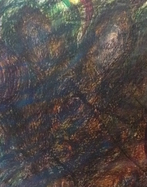次の練習問題を解き終えた (全体の見直しはまだ).
($a$) 任意の単一の群はそれ自体圏と見做せる. 圏としての群の逆圏は何かを説明せよ. この圏が元の圏としての群と同型になること, および同型ではあるが, 同一となるとは限らないことを示せ.
($b$) 上の ($a$) と同様のことをモノイド (結合律を満たす 2 項演算と単位元を持つ集合 = 単位元を持つ半群) に対して行え. その際, 逆圏としてのモノイドが元のモノイドと必ずしも同型にならないことを示せ.
($c$) 上の ($b$) と同様のことを半順序集合に対して行え.
($b$) 群と同様, 任意のモノイドは圏と考えることができる.
$M$ を任意のモノイドとする. $M$ は単位元 '$e$' を持ち, $M$ 上の積 '$・$' は結合律を満たす.
モノイド $M$ を圏として構成する.
対象の集合 $O$ を 1 個だけの元 ('$\bullet$' により表わす) からなる集合として,
\begin{equation*}
O = \left\{\, \bullet \,\right\}
\end{equation*} と定義する.
射の集合 $A$ をモノイド $M$ 自身により
\begin{equation*}
A = M
\end{equation*} と定義する.
$A = M$ の各元 $x$ を, 対象 $\bullet \in O$ からそれ自身への射と考えて
\begin{equation*}
x : \bullet \longrightarrow \bullet
\end{equation*} と記す.
関数 $d^0, d^1 : A \to O$, $u : O \to A$, $m : P = A \times A = M \times M \to A$ を次のように定義する.
・ $d^0, d^1 : A \to O$ は各 $(x : \bullet \to \bullet) \in A$ に対してソース $\bullet$ とターゲット $\bullet$ を対応させる関数.
\begin{equation*}
d^0(x) = \bullet, \quad d^1(x) = \bullet \quad (x \in A).
\end{equation*}
・ $u : O \to A$ は唯一の対象 $\bullet$ に対してモノイド $M$ の単位元 $e$ を対応させる関数.
\begin{equation*}
u(\bullet) = (e : \bullet \to \bullet) = e.
\end{equation*}
・ $m : P \to A$ は各 $(x, y) \in P$ に対して
\begin{equation*}
m(x, y) = xy = x \cdot y
\end{equation*} により定義される関数.
モノイド $M$ を 6 つ組
\begin{equation*}
M = (A, O, d^0, d^1, u, m)
\end{equation*} と表わす.
このとき $M$ がモノイドであることから以下のような図式の可換性が成立する.
(i) $M$ が単位元を持つこと (これにより空集合 $\varnothing$ はモノイドになり得ない. 群の場合と同じ) を示す図式:
\begin{equation*}
\xymatrix@=48pt {
A \ar[dr]_{d^0} & O \ar[l]_{u} \ar[d]^{\mathrm{id}_{O}} \ar[r]^{u} & A \ar[dl]^{d^1} \\
~ & O & ~
}
\end{equation*}
(ii) $M$ 上の積が $M$ に関して閉じていることを示す図式:
\begin{equation*}
\xymatrix@=48pt {
P \ar[d]_{m} \ar[r]^{p_2} & A \ar[d]^{d^0} & P \ar[d]_{m} \ar[r]^{p_1} & A \ar[d]^{d^1} \\
A \ar[r]_{d^0} & O & A \ar[r]_{d^1} & O
}
\end{equation*} ここで $p_1, p_2 : P \to A$ は座標射影で $p_1(x, y) = x,\, p_2(x, y) = y$ により定義される.
(iii) 任意の $x \in M$ に対して単位元 $e$ が $x \cdot e = x = e \cdot x$ を満たすことを示す図式:
\begin{equation*}
\xymatrix@=48pt {
A \ar[dr]_{\mathrm{id}_{A}} & P \ar[l]_{(\mathrm{id}_{A}, u \circ d^0)} \ar[d]^m \ar[r]^{(d^1 \circ u, \mathrm{id}_{A})} & A \ar[dl]^{\mathrm{id}_{A}} \\
~ & A &
}
\end{equation*}
(iv) $M$ 上の積が結合律を満たすことを示す図式:
\begin{equation*}
\xymatrix@=48pt {
Q \ar[d]_{m \times \mathrm{id}_{A}} \ar[r]^{\mathrm{id}_{A} \times m} & P \ar[d]^m \\
P \ar[r]_m & A
}
\end{equation*} ここで $Q = A \times A \times A = M \times M \times M$ である.
これによりモノイド $M$ を圏と見做すことができる.
モノイド $M$ を圏と見做したとき, その逆圏 $M^{\mathrm{op}}$ もモノイドになることがわかる.
モノイド $M^{\mathrm{op}}$ の各元を, $x \in M$ に対して $x^{\mathrm{op}}$ と記すことにする.
$M^{\mathrm{op}}$ は 6 つ組
\begin{equation*}
M^{\mathrm{op}} = (A^{\mathrm{op}}, O^{\mathrm{op}}, d^{0,\mathrm{op}}, d^{1,\mathrm{op}}, u^{\mathrm{op}}, m^{\mathrm{op}})
\end{equation*}
として定義する. 個々の構成要素は次のように定められる.
・ 対象の集合 $O^{\mathrm{op}} = \mathrm{Ob}(M^{\mathrm{op}}) = O = \left\{\, \bullet \,\right\}$: 単一の元のみからなる集合.
・ 射の集合 $A^{\mathrm{op}} = \mathrm{Ar}(M^{\mathrm{op}}) = M^{\mathrm{op}}$: モノイド $M$ の台集合の上に積 "$\cdot^{\mathrm{op}}$" を入れて定まるモノイド (後述: $x \cdot^{\mathrm{op}} y = y \cdot x$ により定義される).
・ $d^{0,\mathrm{op}}, d^{1,\mathrm{op}} : A^{\mathrm{op}} \to O^{\mathrm{op}}$ は各 $(x : \bullet \to \bullet) = x \in \mathrm{Ar}(M^{\mathrm{op}}) = M^{\mathrm{op}}$ に対して唯一の対象 $\bullet$ を対応させる関数.
・ $u^{\mathrm{op}} : O^{\mathrm{op}} \to A^{\mathrm{op}}$ は $\bullet \in O^{\mathrm{op}}$ に対して $M^{\mathrm{op}}$ の単位元
\begin{equation*}
u^{\mathrm{op}}(\bullet) = (e^{\mathrm{op}} : \bullet \to \bullet) = e^{\mathrm{op}}
\end{equation*} を対応させる関数.
・ $m^{\mathrm{op}} : P^{\mathrm{op}} = M^{\mathrm{op}} \times M^{\mathrm{op}} \to M^{\mathrm{op}}$ は各 $(x^{\mathrm{op}}, y^{\mathrm{op}}) \in P^{\mathrm{op}}$ に対して
\begin{equation*}
m^{\mathrm{op}}(x^{\mathrm{op}}, y^{\mathrm{op}}) = x^{\mathrm{op}}y^{\mathrm{op}} = x^{\mathrm{op}} \cdot^{\mathrm{op}} y^{\mathrm{op}} = y \cdot x
\end{equation*} により定義される関数.
モノイド $M$ と逆圏としてのモノイド $M^{\mathrm{op}}$ の違いは群の場合と同様に積の構造にある.
関数 $i : M \to M^{\mathrm{op}}$ を
\begin{equation*}
i(x) = x^{\mathrm{op}} \quad (x \in M)
\end{equation*} と定義すると, これはモノイドの準同型写像となる (群の場合は同型写像となるが, モノイドの場合は同型になるとは限らない).
$m^{\mathrm{op}}$ の定義により, 任意の $x, y \in M$ に対して
\begin{equation*}
x^{\mathrm{op}} \cdot^{\mathrm{op}} y^{\mathrm{op}} = y \cdot x
\end{equation*} が成り立つ.
$i$ は $M$ の 2 つの元の積 $x \cdot y \,(x, y \in M)$ を $M^{\mathrm{op}}$ における積に
\begin{equation*}
i(x \cdot y) = x^{\mathrm{op}} \cdot^{\mathrm{op}} y^{\mathrm{op}} = y \cdot x
\end{equation*} と移す.
したがって群の場合と同じく, $M$ と $M^{\,\mathrm{op}}$ は台集合は同じだが積 " $\cdot$ " と " $\cdot^{\mathrm{op}}$ " が異なるために一般に同じモノイドにはならない.
■ モノイド $M$ と逆圏としてのモノイド $M^{\mathrm{op}}$ が準同型ではあるが同型にはならない例:
実数体 $\mathbb{R}$ 上の $2 \times 2$ 行列全体のなす環 $M_2(\mathbb{R})$ を考える.
単位行列と零行列を
\begin{equation*}
1 = \begin{bmatrix}
1 & 0 \\
0 & 1
\end{bmatrix}, \quad
0 = \begin{bmatrix}
0 & 0 \\
0 & 0
\end{bmatrix}.
\end{equation*}
と表わす.
$c$ を 0 でない実数とし, 元 $a, b \in M_2(\mathbb{R})$ を
\begin{equation*}
a = \begin{bmatrix}
1 & 0 \\
0 & 0
\end{bmatrix}, \quad
b = \begin{bmatrix}
0 & c \\
0 & 0
\end{bmatrix}.
\end{equation*} と定義する. $a, b$ に関して
\begin{align*}
a^2 &= a, \\
b^2 &= 0, \\
a \cdot b &= b, \\
b \cdot a &= 0
\end{align*} が成り立つ.
$M$ を $0, 1, a, b$ が生成するモノイドとする. 上記の $a, b$ の関係により,
\begin{equation*}
M = \left\{\, 0,\, 1,\, a,\, b \,\right\}
\end{equation*} となる.
$h : M \to M^{\mathrm{op}}$ をモノイド $M$ から逆圏としてのモノイド $M^{\mathrm{op}}$ への任意のモノイドの準同型写像とする.
このとき, $h$ は同型写像にはなり得ない.
証明は $h$ が $M$ の各元を $M^{\mathrm{op}}$ のどの元に移すのかを調べていくことにより行える.
$h$ はモノイドの準同型だから
\begin{equation*}
h(1) = 1
\end{equation*} を満たす. これ以外の $M$ の元 $0, a, b$ と $M^{\mathrm{op}}$ の元との対応が上記の $a, b$ の関係により全射にならないことがわかる.
よって同型写像ではない.
同時に $h$ の値を定めていく過程で $h$ が $M$ から $M^{\mathrm{op}}$ への同型でない準同型になることもわかる.
【このカテゴリーの最新記事】
-
no image
-
no image
-
no image
-
no image
-
no image
